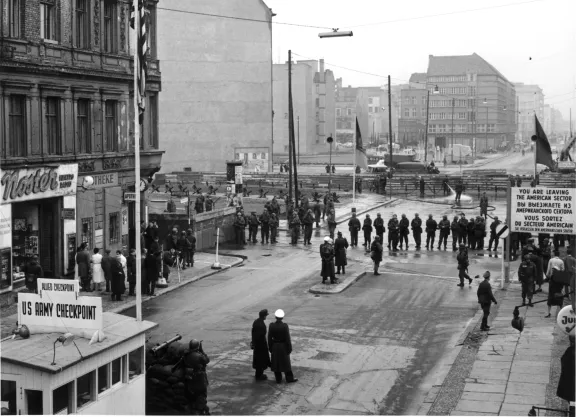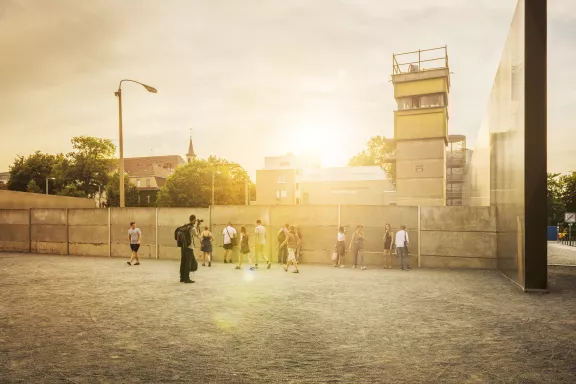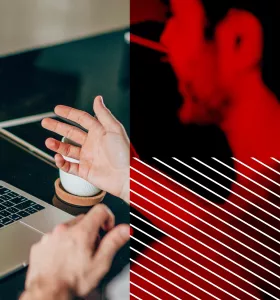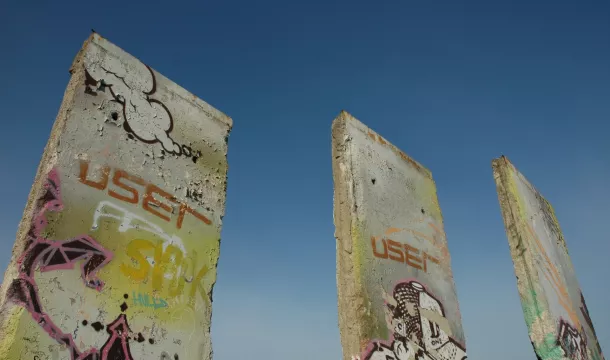The Berlin Wall: History at a Glance
History – Testimonies – Relics

For more than 28 years East and West Berlin were divided by an almost insurmountable Wall. Not only did it divide families and friends but it also brought much pain and suffering to the city. At least 136 people lost their lives here, mostly when attempting to flee from East to West. The joy which accompanied the fall of the wall on 9th November 1989 generated a feeling of euphoria in which the majority of border posts disappeared. There are only a few original relics left. The following round-up is intended to help with the search for evidence. In addition, it will provide an insight into the history of the Wall and highlight the dramatic events that took place on 9th November 1989.
The Wall – the Background up to its Construction in 1961
As early as during the course of the Second World War the Allies had resolved to divide Germany, once defeated, into occupation zones and allow the country to be administered by the victorious powers, that is, the USA, Great Britain and the USSR. France only came on board as the fourth occupying power after the Yalta Conference in February 1945. At the Conference held in Potsdam at the beginning of August 1945, the victorious powers approved the four zones and the four sectors of Berlin, the eastern boundary along the Oder Neiße line as well as the economic unit of Germany. Nevertheless, the first signs of the Cold War were already becoming evident. In the Western and the Eastern Zones a very different pattern of development evolved. In May 1949 the Federal Republic of Germany was established with Bonn as its capital city; in the October of that year the German Democratic Republic was formed (GDR). The borders were still open but they were being watched. However, this situation was set to undergo a rapid change. In a number of operations, one of which went by the (telling) name of “Vermin“, persons who, in the eyes of the Socialist Unity Party (SED), were “not to be trusted” were forcibly expelled from the border area. Although controls on the internal German borders were tightened, Berlin still continued to offer a good escape route for people fleeing from East to West. The Soviet leaders regarded free West Berlin as a “splinter“ in the heart of “socialist Europe“ that had to be removed. In the spring of 1961 the economic situation in the GDR worsened dramatically. There was a significant increase in the flow of refugees. It seemed that the GDR was on the brink of collapse, both economic and political. Thousands of people were turning their backs on the country.
The Building of the Wall – 13th August 1961
The summit talks between Nikita Khrushchev, Party Chief and Soviet Head of State, and the American President John F. Kennedy on 3rd and 4th June 1961 in Vienna failed to defuse tensions in the Cold War. On 15th June 1961 SED Chief Walter Ulbricht was still trying to dispel rumours that West Berlin was about to be sealed off. “Nobody has any intention of erecting a wall“, he announced. In the early hours of 13th August 1961 this was exposed as a piece of lying propaganda. Under conditions of the strictest secrecy – only a few hundred officials and civil servants are said to have known about the date – armed workers’ militia groups, police and soldiers embarked on the construction of a barrier made from concrete blocks and barbed wire across the city along the boundary between the sectors of East and West Berlin. The West’s response was initially surprisingly low-key. It was only two days later that the West’s commanders in the city were motivated to launch a protest.
Facts
- The Wall around West Berlin was a total of 156.4 kilometres in length; the border between West and East Berlin accounted for 43.7 kilometres of it.
- 13th August 1961 may have been the day the Wall was built. All traffic routes between West and East Berlin were cut, but it was several days before an almost complete cordon was in place.
- The demolition of the internal city wall, which commenced on 10th November 1989 with the opening up of new border crossing points, was officially completed on 30th November 1990.
- In the surrounding area of Brandenburg the last sections disappeared in November 1991.
- Some of the sections of the wall can be found today in different places throughout the world. The US Secret Service, the CIA, secured a few artistically decorated segments of the wall for its building
- A few segments of the wall with St. Michael’s Church painted on them were erected in the Vatican Gardens in August 1994.
- Another piece of the wall is on view in the House of History (‘Haus der Geschichte’) in Bonn.
- According to research carried out by the Centre for Research into Contemporary History and the Berlin Wall Memorial Site - between 1961 and 1989 at least 136 people were killed on the Berlin Wall ...
- or lost their lives in circumstances in which the GDR border regime was directly implicated.
- In addition, at least 48 travellers from East and West died before, during or after checks at Berlin crossing points.
The Circumstances Surrounding the Fall of the Berlin Wall
The surprise opening of the barriers at a number of Berlin border crossing points on the evening of 9th November 1989 is frequently represented as the result of misunderstandings within the leadership of East Germany. In fact, there were a number of events that preceded the stampede of thousands of GDR citizens who fell upon the completely unprepared border guards, and the importance of these events in terms of world history could not be foreseen at the time.
1989 –Year of Upheaval: the Opening of the Border in Hungary
On 2nd May 1989 Hungarian border soldiers started dismantling the barbed wire fence between Hungary and Austria under the supervision of the Foreign Ministers of both countries. Confident that the border would continue to be secured, the GDR passed this off as simply a “cosmetic border operation“. Initially there was no change to the situation. Even though it had acceded to the Geneva Convention Relating to the Status of Refugees, Hungary was still deporting GDR escapees back to their homeland. The situation only began to change over the course of the following few weeks. By mid-July it was being increasingly reported that refugees from the GDR were being handed over to the GDR authorities on fewer and fewer occasions. Finally, on 19th August, the Iron Curtain between East and West opened after more than four decades of the Cold War. On the occasion of a “Pan-European Picnic“, the border gate to Austria was opened for three hours on 19th August. More than 600 GDR citizens made use of this opportunity to flee into the West. And, in other places, tens of thousands of people wanting to leave were waiting for their chance. The Embassy of the Federal Republic of Germany in Budapest was hopelessly crammed and the same was true in Prague and Warsaw. Starting on 11th September, Hungary opened its borders up to citizens of the GDR. In the first three days alone, 18 000 of them made their way into Austria and from there on into the Federal Republic of Germany.
Embassy Refugees
During the summer of 1989, more and more GDR citizens attempted to leave for the West via the Embassies of the Federal Republic of Germany in Prague, Warsaw and Budapest. In September of that year a particularly dramatic situation arose in Prague, with 3 500 people jostling in the building and in the garden. The GDR leadership saw their celebrations to mark the 40th anniversary of the founding of the Republic on 7th October in jeopardy, whilst the Federal German government was anxious to do what it could to help the people. To scenes of indescribable jubilation, Foreign Minister Hans-Dietrich Genscher announced, on 30th September, that all embassy refugees could leave. Because by now increasing numbers of GDR citizens were occupying the Embassy, trains were laid on over the next few days to carry a total of 17 000 refugees from Prague to the Federal Republic of Germany via the GDR. On 3rd October the GDR closed its borders to the ČSSR. On 4th October a serious dispute with the police erupted at the main station in Dresden when thousands of extra people tried to board the trains.
Monday Demonstrations
Rumours were also rife internally in the GDR. The City of Leipzig, through its Monday Demonstrations, became the symbol of the Peaceful Revolution. On 4th September an initial demonstration by around 1 200 people took place following the Monday prayers for peace in St. Nicholas’ Church. Demonstrators anxious to leave shouted “We want out!“ Two weeks later it was the choir, chanting “We are staying here!” who prevailed. Arrests were made. By 2nd October there were 20 000 people taking part in the Monday Demonstrations. It is here that the slogan that subsequently became so meaningful “We are the people! “was chanted for the first time, conceived originally merely as a response to the loudspeaker announcement “This is the People’s Police”. On 23rd October the number of participants had risen to 300 000. In the wake of church services in Magdeburg, Dresden, Schwerin, Zwickau, Halle, Stralsund and Berlin too, thousands of people took the opportunity to demand free elections, authorisation of opposition groups and freedom to travel. The turn of the tide in the GDR was by now unstoppable, even if at the time no-one could yet imagine that the Wall would come down quickly.
The Events of 9th November: A Normal Everyday Meeting of the Central Committee
On the morning of 9th November the Central Committee of the State Party, the SED, met for one of its regular meetings. The 231 members and candidates from all parts of the GDR were to debate economic policy, the authorisation of the Reform Movement ‘New Forum’ as well as a new version of a travel law. As regards the first draft (which had actually been rejected by the relevant committee of the People’s Chamber of the GDR Parliament) there was now to be a permanent right to leave the country and to undertake private journeys away from the GDR. The Czech government in particular had exerted strong pressure on the East Berlin leadership to halt the flow of refugees leaving the GDR via their country. Hence the new travel law was rubber-stamped by the Central Committee at around 4pm without any discussion.
Schabowski at the Press Conference at 6.53 pm
An hour later Günter Schabowski, the acting spokesman for the Politburo of the Central Committee of the SED, who had not been present at the Meeting of the Central Committee, received the draft of the Travel Act from SED General Secretary Egon Krenz. Schabowski recalls Krenz saying “This will make a big splash“. Schabowski rushed into the international Press Conference with the text. Then, at 6.50 pm, uttered the crucial sentences: “And for this reason we have (er) decided to implement (er) a regulation that will make it possible for any citizen of the GDR (er) to travel beyond (er) GDR border crossing points“. On being asked by an Italian correspondent when the new regulation was scheduled to come into force, Schabowski rummaged around in his papers and spluttered:
”According to my information, immediately, without delay“.
Right up to the present day Egon Krenz has always maintained that the paper bearing the new travel regulation was confidential information and bore a note to this effect. It was not until the morning of the following day – at four o’clock precisely – that the news was to have been broadcast on GDR radio. Schabowski later dismissed this version as a crazy idea. “No way could they have issued a statement to the world press several hours before, then decided to seal their lips, typewriters and telephones by means of an ‘embargo’. Not even the GDR Press, accustomed as it was to orders, would tolerate being trussed up like that“, he declared.
Newsflash shortly after 7.00 pm
Shortly after 7.00 pm the first newsflashes from western news agencies, screaming “GDR opens the border”, were coming over the ticker. ARD Television’s main news broadcast, “Tagesschau“, also began its broadcast at 8.00 pm with this truly sensational item of news. A short time later the first hundred people were elbowing their way through at the crossing points at Bornholmer Straße and Heinrich-Heine-Straße. On the Böse Bridge the first few individuals were let through to the West at around 9.30 pm. These were, by all accounts, ”provocative persons“. According to an instruction from the Ministry for State Security (Stasi), these persons were to have their passport photographs stamped so that they could be refused re-entry to the GDR. ‘’The GDR citizens saw that we were allowing a few people to leave“, recalled Lieutenant Colonel Harald Jäger who was on passport control duty in the Bornholmer Straße. ”They didn’t appreciate why. They assumed it was happening there and then“. Shortly after 11.00 pm the number of people at this crossing point alone increased to 20 – 30,000 after the ARD daily roundup had announced the”opening of all the borders“. In view of the pressure, the border officials were forced to suspend checks.
Wall Memorial Sites

Berlin Wall Memorial
There has been a Memorial Ensemble on the Bernauer Straße between the districts of Wedding and the Central Area since the end of the 1990s. These include the Berlin Wall Memorial Site, the Berlin Wall Documentation Centre along with the Chapel of Reconciliation. Here one section of the Wall has been rebuilt in its original location. There is an exhibition and a great deal of information about the Wall. An excellent view can be obtained from a viewing tower. The Chapel of Reconciliation was built over the foundations of the choir of the Church of Reconciliation that was blown up in 1985. Those who died on the Wall are remembered here on Tuesdays to Fridays from 12.00 – 12.15 pm
Berlin Wall History Mile
The Berlin Wall History Mile is a permanent exhibition in four languages. At 31 different stations along the inner city Wall Trail, it tells the story of the partition, the building of the Wall, and the opening up of the Wall. It features historical photos and texts that describe the events that took place at each of the locations and illustrate both the political situation and everyday life in the divided city. In the city centre the former course of the Berlin Wall is marked with a double row of cobblestones and cast iron plaques set in the ground “Berlin Wall 1961–1989“. By following the markings, traces of the border posts are discernible on foot.
Some plaque locations:
Bornholmer Straße / Bösebrücke
Bernauer Straße 48 and 78
Chausseestraße / Corner of Liesen Straße
“White Crosses“ Memorial Site Reichstagufer
Potsdamer Platz
Heinrich-Heine-Straße
Sonnenallee
East Side Gallery
Along the Mühlenstraße in Friedrichshain (close to the East Station) there is a work known as “Hinterlandmauer“ which was painted in 1990 by 118 artists, both men and women, from 21 countries. The images express the joy that greeted the fall of the Berlin Wall. The actual border ran along the Kreuzberg Bank opposite. But in order to quickly apprehend fugitives, the standard arrangement of signal security fence, patrol road, searchlights and border security fence was constructed along the road behind the wall. More information.
Tränenpalast
The permanent exhibition in Berlins Tränenpalast, "Site of German Division", will offer original exhibits such as old observation cameras and interviews with time witnesses. The Tränenpalast is an appropriate venue for that exhibition. It was built in 1962 as terminal building for the departure from East to West Berlin.
Allied Museum
The Allied Museum recounts the story of the Western powers in Berlin from 1945 to 1994. One of the items on show in the exhibition is the world famous sentry post of Checkpoint Charlie in the Friedrichstraße / Zimmerstraße, as well as a number of other exhibits forming part of political, military and everyday history.
German-Russian Museum
On 8th May 1945 Field Marshal General Keitel signed an unconditional surrender of the German Armed Forces in the Pionierschule which had been captured by the Red Army and which was subsequently the official headquarters of the Soviet Military Administration. The permanent exhibition depicts German-Soviet relations from 1917 to 1990; the museum primarily commemorates the war in the East between 1941 and 1945.
Marienfelde Refugee Centre
The historic location which is the Memorial Site features an exhibition centring on the escape movement from one side of Germany to the other. West Berlin’s Marienfelde refugee centre was the first port of call for many fugitives from the GDR. 1.35 million people were given shelter here from 1953 to 1990. The exhibition provides information on what made people decide to flee and the routes they used for making their escape, the stages the fugitive had to go through before being granted the status of refugee, the new start in the west and how the state security forces used to spy on refugees.
Wall Museum
This private museum is dedicated to preserving the memory of the Wall and is devoted to the international battle for human rights. The exhibits include many items that were used by refugees and agents who helped them to escape.
Asisi Panometer Berlin
The 15 metre (50 ft) high Berlin Wall Panorama created by famous artist Yadegar Asisi shows a panorama of daily life on both sides of the Berlin Wall on a fictitious autumn day in the 1980s. Asisi, who lived in Berlin Kreuzberg himself in the 1980s, included East German soldiers on border patrol but also graffiti artists, children playing and drunks at a curry wurst stand in his artwork. Audio sequences and voices of contemporary witnesses complement the visual representation and create an authentic atmosphere.
BlackBox Cold War
The BlackBox Cold War at Checkpoint Charlie informs the public on the history of this most famous border crossing point. With the use of large-format photos and numerous media stations, not only the impact of the Berlin Wall on the history of Germany is illustrated, but also the entire international dimension of the division of both Germany and Europe will be made tangible. Responsible for content is a network of international scientists. This should help to work up the conflict from a multinational perspective.
Günter Litfin Memorial Site
Günter Litfin was shot dead by members of the transport police on 24th August 1961 while trying to flee to West Berlin. He was the first victim of targeted shooting on the border between East and West Berlin after 13th August 1961. This Memorial Site is dedicating to preserving the memory of Günter Litfin and all other victims of the SED dictatorship who were injured or killed by the GDR border regime. Thanks to a private initiative, it has been possible to set up this memorial site in a building that was formerly the operational headquarters for GDR border troops.
From the Memorial Site a footpath and cycle way leads along the Spandauer Schifffahrtskanal via the historic Invalidenfriedhof Cemetery to the former border control point at Invalidenstraße.
Invalidenfriedhof
The Invalidenfriedhof Cemetery was established in 1748 by Friedrich II of Prussia for the community housed in the Invalidenhaus. The cemetery is adjacent to the embankment wall of the Spandauer Schifffahrtskanal. The sector border ran right through the middle of it. Still standing here today are an approx. 180 metre long section of the one-time inner wall (’Hinterlandmauer’), ruptured in a number of places, and a somewhat longer section of the patrol road that sliced through the Invalidenfriedhof Cemetery from 1975 onwards. In 2003 the sections of the wall were renovated by order of the State Office for Historic Monuments and repainted in the colour scheme typical of the East side of the inner Wall - elongated white rectangles in a grey frame.
Location:
Not far from Scharnhorststraße in the central part of Berlin, north of the Federal Ministry of Economics.
Watchtower in the Erna-Berger-Straße (not far from the Potsdamer Platz)
The watchtower that stands on the Erna-Berger-Straße is one of the last of its kind. Inside an iron ladder leads up into the octagonal observation chamber. This type was used from 1969 onwards to secure the border on the Berlin as well as the internal German border. This watchtower in the newly opened up Erna-Berger-Straße was located outside the death strip and was used for primary border security. This was the point used for monitoring the area between the building that formerly housed government departments (now the Federal Ministry of Finance), the Academy of Sciences of the GDR (today the Berlin House of Representatives) and the inner wall on the Stresemannstraße. Because of the number of nooks and crannies, comprehensive surveillance of this area was impossible. In the course of the redevelopment of the site in the post-‘Wende’ (or ‘turning-point’) period, the tower had to be moved around eight metres towards the East.
Berlin Wall Trail
The Berlin Wall Trail runs the whole length of the swathe of the Wall and encompasses the entire western section of Berlin. This cycleway and footpath along the 180 kilometre long section of the former border installations is, in the main, well constructed and has been almost complete since 2005. With the exception of smaller sections, the stretch is asphalted all the way along. The Berlin Wall Trail leads predominantly over (still existing) former customs and patrol routes or newly-built routes in the border strip, otherwise on public traffic areas running parallel to the border.
To assist with making arrangements for a cycle tour or a walk, the Berlin Wall Trail is divided up into 14 individual sections. These are between seven and 21 kilometres in length.
Memorial Site to the Period of the ‘Wende’

Friedrichstraße Station
Following a temporary transition phase that came into force immediately after the building of the Wall was commenced on 13th August 1961, the Friedrichstraße station, which was located exactly on the sector border, was split into a number of strictly segregated areas. Gradually walls and a suspended ceiling were added. In the initial phase incoming and outgoing travel checks took place in the station facilities. A little later on, a separate building for border checks was constructed on the station forecourt – the legendary ‘Palace of Tears’. The name was coined by popular demand because it was here that visitors from the West would say goodbye to their GDR relatives before returning home.
After the fall of the Berlin Wall, the area was discovered by the artistic fraternity who used it up to the summer of 2006. Then extensive construction work began.
One-time Ghost Stations
During the period when the city was partitioned, trains would run without stopping through a number of underground and suburban stations in the Eastern sector of Berlin. Two underground lines and one suburban route cut through the Central district which formed part of the East. They began in the Western sector and, after transit of the East, resumed their journey in the West.
The stations were dubbed “ghost stations“, primarily because of the eerie feeling they evoked during the journey as a result of travelling through a dimly lit yet heavily guarded sector. In the Friedrichstraße and the Chausseestraße in the Eastern sector, passers-by were able to hear the subterranean thoroughfares. The first ghost station to be re-opened was (line U 8) on 11th November 1989 , two days after the fall of the Berlin Wall.
Castle Schönhausen
In the period of the ‘Wende’, the “Round Table“ (as it was known) held interim meetings with representatives of the civil rights movement and the GDR government in buildings adjoining Castle Schönhausen in the Pankow Castle Park on the Ossietzkystraße during 1989/1990. This was also the scene of substantial parts of the Two-Plus-Four negotiations. Today there is a memorial plaque commemorating this period. The Castle now is open to the public. www.spsg.de
The Berlin-Hohenschönhausen Memorial
On the site of the earlier Central Remand Centre of the Ministry for State Security at Genslerstraße 66, there is a memorial site which has been there since 1994. Because major sections of the building and the facilities have survived almost intact, the memorial site imparts a highly authentic picture of the prison regime in the GDR.
The permanent exhibition give aside from tours an additional insight into the experiences of former detainees and the history of the Stasi-prison. For the first time, the Memorial will also present the world of the offenders in a separate part of the exhibition by showing short biographies of former Stasi-employees from the prison management or interrogation. A visit to the former Stasi prison is only possible within the context of a guided tour.
Permanent exhibition „Daily life in the GDR“
The permanent exhibition deals with the history of the product- and everyday life-culture in the GDR and illustrates with furniture, photos, books and cars the daily life of the Germans in the socialist country. The exhibits show which strategies the people in the GDR applied to deal with the political ideology and how they were stretched to their limits by finding normality in a system full of surveillance and instructions.
Since 2005, visitors of the museum can already come to see the “Collection of Industrial Design”, which displays everyday things and design objects during the GDR. The broad range of exhibits shows creative ambitions as well as manufacturing problems and supply gaps during this time in former East Germany. A woman in the district Prenzlauer Berg for example created her own fashion line, which was very rare in the former GDR. Her success can be seen as a big exception in the political system of the GDR.
Stasi-Museum
Building 1 of the business complex of the Ministry for State Security of the GDR (MfS) in Berlin-Lichtenberg, where Erich Mielke, the last Minister, once resided, is where the Normannenstraße Research and Memorial Site, known today as the Stasi Museum, can be found. Beside Mielke’s offices, which have to a major extent been maintained in their original condition, the operational technique of the MfS, concealed cameras, microphones and weapons bear witness to the ubiquitous spying operations inflicted on the people of the GDR. Likewise on view is the extremely quaint collection of items of the MfS, such as banners, medals, busts of Lenin and portraits.
DDR Museum
The DDR Museum close to Museum Island presents the daily life in the former GDR. The motto of the museum is “Hands on History”, a principle that can be taken literally: whether watching TV in a GDR-living room, rummaging in drawers or driving in a Trabant through a simulated area of prefabricated houses – here, every visitor is encouraged to experience the daily life in the GDR first-hand. In addition, the museum does not only offer guided tours within the exhibition, but also to important historical sites in the city itself. Due to its high level of interactivity, the museum is especially suitable for children and families, but also impressively coveys older visitors 40 years of GDR-history.
Special Guided Tours
The traces of the Wall and the former GDR can also be experienced outside of a museum. The Berlin Wall Memorial offers special guided tours that show the former presence of the Wall in Berlin’s urban image. More information.
Fotos
Photographs of the Berlin Wall you can find here
More information at wall.visitBerlin.com.





